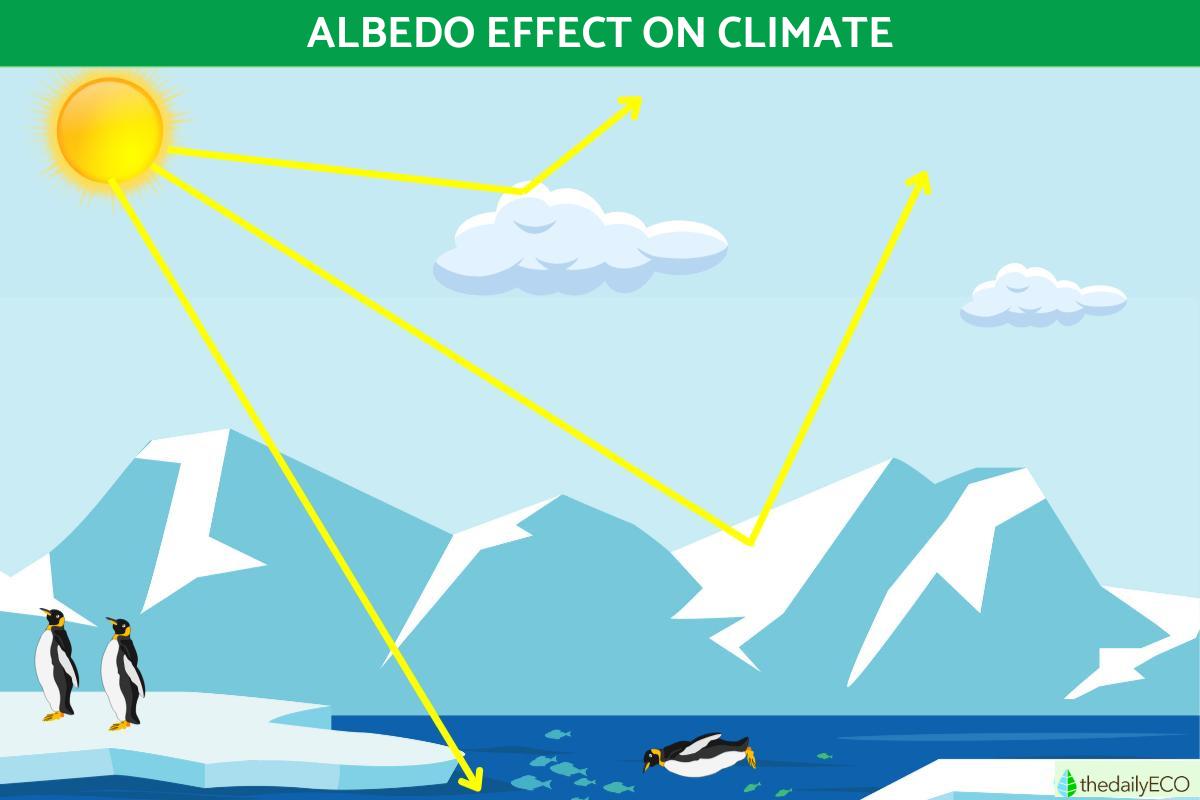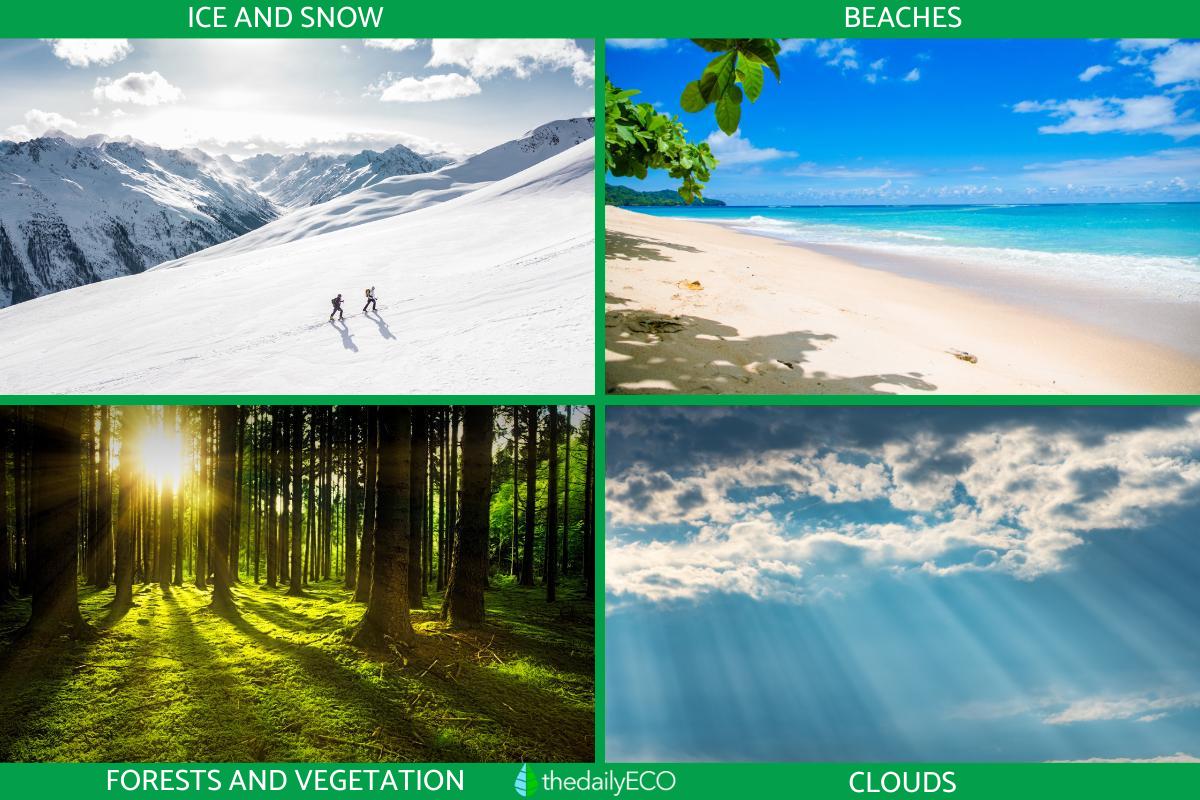What Is the Albedo Effect on Climate?


The albedo effect is a measurement used in geoscience which helps us to understand the effects of climate change and global warming. Essentially, the albedo effect is a measurement of the properties of light reflected from a given object. The lighter the surface, the greater its ability to reflect radiation and, therefore, the greater the albedo. The amount of sunlight reflected back from Earth into space is around 30 to 35 percent. The Earth's high albedo means it retains less energy and we are not constantly accumulating heat. With the melting of the Polar caps this is changing.
In this thedailyECO article, we ask what is the albedo effect on climate? We better understand the concept of the albedo effect by looking at its action and see examples of how it affects our climate.
What is the albedo effect?
The albedo effect is a phenomenon in science that refers to the ability of a surface to reflect solar radiation. Essentially, its definition is the measure of the reflectivity of a surface, specifically how it reflects sunlight. While it is a concept deeply linked to physics, it is fundamental in the natural sciences to understand how our planet's climate works. It has a significant impact on our understanding of climate change and how this affects terrestrial ecosystems.
The solar energy that reaches Earth is made up of visible light and infrared radiation. When this radiation reaches the Earth's surface, some of it is absorbed and some of it is reflected back into space. The absorbed radiation causes the Earth's surface to heat up. The amount of reflected solar radiation depends largely on the nature of the surface in question. More reflective surfaces have a high albedo, while less reflective surfaces have a low albedo.
The albedo effect has a direct impact on the Earth's global climate. High-albedo surfaces include the polar ice caps which melt due to global warming. When this happens, they are replaced by lower-albedo surfaces such as ocean water. This means that more solar radiation is absorbed rather than reflected back into space, contributing to rising global temperatures.
Different surfaces alter the albedo effect. We can see how the albedo effect works on icebergs in the diagram below.

Albedo effect factors
The factors on which the albedo effect depends include the following:
- Type of surface and its color: light surfaces such as snow and ice have a high albedo due to their ability to reflect sunlight. In contrast, dark surfaces such as asphalt and urban areas have a low albedo and tend to absorb more heat.
- Angle of incidence: when the sun's rays reach a surface perpendicularly, it tends to reflect more light, which increases its albedo. The sun's rays can arrive at an acute angle, such as at the end of the day or near the poles. When this happens, the surface tends to absorb more solar radiation. In turn, this decreases its albedo.
- Surface condition: the albedo of freshly fallen snow is higher than that of melted snow or dirty snow. Fresh snow is highly reflective due to its smooth surface and its ability to reflect light without absorbing it.
- Vegetation cover: vegetated surfaces such as forests and grasslands tend to have a lower albedo compared to bare surfaces. This is becauses plants absorb some of the solar radiation to carry out photosynthesis.
- Pollution and aerosols: aerosol particles can scatter sunlight, which can increase the amount of reflected radiation. Particles in the atmosphere can also settle on surfaces, darkening them and lowering their albedo.
- Seasonal and climate changes: snow cover in the polar regions increases during winter, temporarily increasing the albedo of those areas. Likewise, changes in weather patterns can influence the amount of clouds in the atmosphere, which in turn affects the amount of solar radiation that reaches the surface.
Examples of the albedo effect
These are some examples of the albedo effect:
- Ice and snow: snow and ice in the polar regions have a high albedo and reflect most of the solar radiation that reaches them. This helps keep temperatures in these areas low, as much of the sun's heat is reflected back into space. Due to climate change, the shrinking polar ice cover is decreasing the albedo of these areas, contributing to an increase in local temperatures. Learn more about sea ice with our article on iceberg formation.
- Beaches and sand: although not as reflective as snow, they still reflect a significant amount of solar radiation, helping to maintain cooler temperatures in coastal areas.
- Urban roofs and pavements: cities tend to have lower albedos due to the presence of dark roofs, asphalt and concrete pavements, and glass buildings.
- Forests and vegetation: vegetated areas, such as forests and grasslands, have moderate to low albedos, as plants absorb some of the solar radiation for photosynthesis. You can discover different types of forests with our related article.
- Clouds: high and bright clouds reflect a significant amount of solar radiation back into space, which can have a cooling effect on Earth. Low and thick clouds can block sunlight and reduce the amount of reflected radiation, contributing to warmer surface temperatures.
- Artificial reflective surfaces: in an effort to combat urban heat, some cities are using more reflective building materials, such as white roofs and reflective pavements.
Discover more about how the atmosphere can affect light reflection with our article on what is haze weather?

How the albedo effect affects climate
The consequences of the albedo effect can be significant and have a direct impact on various aspects of our planet, from global climate to local ecosystems. In particular, it affects climate and global warming. The following are some of the main consequences of how albedo effect on our planet:
- Climate change: reflective surfaces such as ice caps and snow layers melt due to rising temperatures. As this occurs, they are replaced by less reflective surfaces, such as ocean water or bare soil.
- Melting of glaciers and polar ice: the albedo effect is especially relevant in polar regions. As ice sheets and glaciers become less reflective and darker due to melting ice and particle accumulation, their melting accelerates. This is a vicious cycle of global heating and can also affect sea ice.
- Change in precipitation patterns: the albedo effect can also affect precipitation patterns. Warmer, less reflective surfaces can heat the surrounding air. This can alter wind patterns and atmospheric currents. Learn more about the difference between weather and climate.
- Impact on urban life: higher temperatures in cities due to low albedo surfaces increase the risks of heat stroke, increase energy demand for cooling and negatively affect people's health.
Now we know the albedo effect definition and how it alters climate, you may want to know about the different types of climate in our ecosystems.
If you want to read similar articles to What Is the Albedo Effect on Climate?, we recommend you visit our Facts about nature category.







